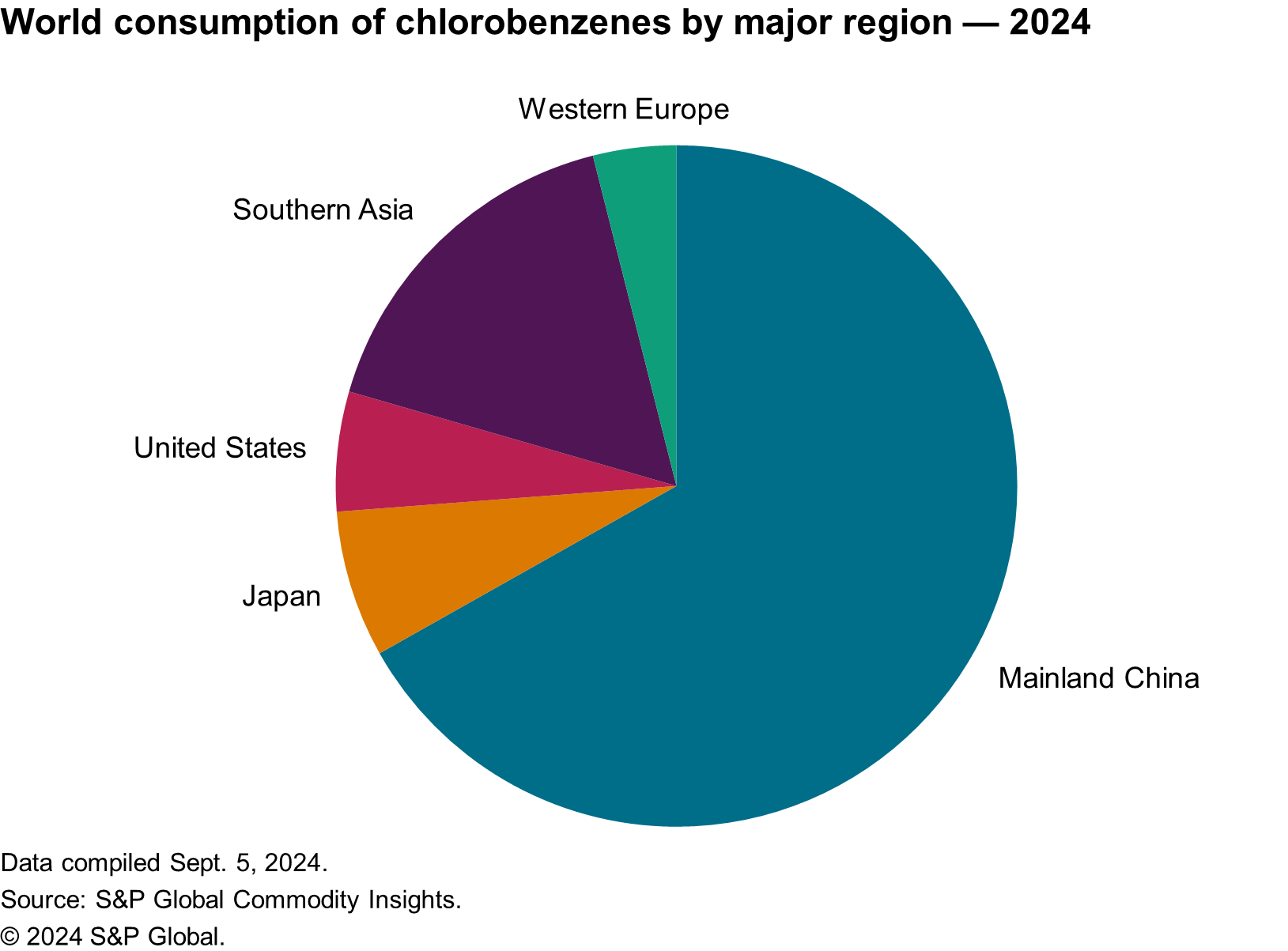Published October 2024
Only three of the many possible products resulting from the chlorination of benzene continue to have any large-volume applications — monochlorobenzene, o-dichlorobenzene and p-dichlorobenzene — combined they account for about 97% of the total chlorobenzenes market. Other chlorobenzenes that have commercial applications but are not produced on a large scale include m-dichlorobenzene, trichlorobenzenes, tetrachlorobenzenes and hexachlorobenzene. Market information on these products is included in the report where available.
The following pie chart shows consumption of chlorobenzenes in the major regions in 2024:

Mainland China is still the world’s largest producer and consumer of chlorobenzenes, accounting for two-thirds among the five major regions. Due to strong consumption growth in Southern Asia, consumption share of this region has grown to nearly 17%.
Mononchlorobenzene accounts for two-thirds of total chlorobenzene consumption in the five major regions in 2024. This is followed by p-dichlorobenzene at about 24%, and o-dichlorobenzene at 7%; all other chlorobenzenes account for 3%.
Nitrochlorobenzene is the most significant end use for monochlorobenzene, and is consumed as an intermediate in the manufacture of dyes and pigments, rubber-processing chemicals, pesticides, pharmaceuticals, and other organic chemicals.
o-Dichlorobenzene is a chemical intermediate consumed mostly for 3,4-dichloroaniline in the United States, Latin America and the Caribbean, and Western Europe; as an herbicide intermediate in Japan; and for pesticides and pharmaceuticals in mainland China and in Southern Asia.
Worldwide, p-dichlorobenzene is used primarily as a raw material for polyphenylene sulfide (PPS) resins, for deodorant blocks for indoor air and for moth control. Polyphenylene sulfide resin is a growing high-performance engineering resin that is produced in the United States, Japan, mainland China and South Korea.
In general, demand for chlorobenzenes in more industrialized regions has been declining for the past few decades as a result of substitution of alternative chemistry in the production of such products as phenol, rubber chemicals and moth-control agents. Growing environmental concerns over use in herbicides and solvents have also contributed to the decline of some chlorobenzenes. However, relatively stronger growth in mainland China and Southern Asia and growing global demand for p-dichlorobenzene have stabilized this trend. Good growth of pharmaceuticals, and polyphenylene sulfide resins have driven consumption of chlorobenzenes over the last several years and will continue to do so. Consumption of chlorobenzenes is also expected to be driven by positive demand from diverse end uses such as agricultural chemicals, rubber chemicals, antioxidants, pigments and solvent uses in mainland China and Southern Asia.
For more detailed information, see the table of contents, shown below.
S&P Global’s Chemical Economics Handbook – Chlorobenzenes is the comprehensive and trusted guide for anyone seeking information on this industry. This latest report details global and regional information, including

Key Benefits
S&P Global’s Chemical Economics Handbook – Chlorobenzenes has been compiled using primary interviews with key suppliers, organizations and leading representatives from the industry in combination with S&P Global’s unparalleled access to upstream and downstream market intelligence, expert insights into industry dynamics, trade and economics.
This report can help you:
- Identify trends and driving forces influencing chemical markets
- Forecast and plan for future demand
- Understand the impact of competing materials
- Identify and evaluate potential customers and competitors
- Evaluate producers
- Track changing prices and trade movements
- Analyze the impact of feedstocks, regulations and other factors on chemical profitability


















